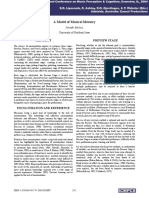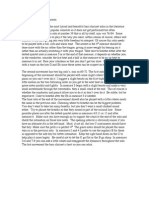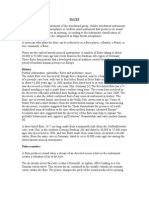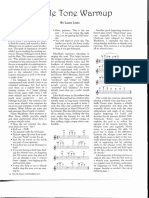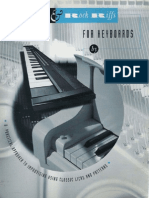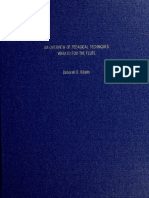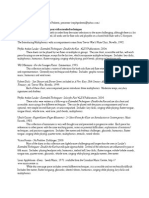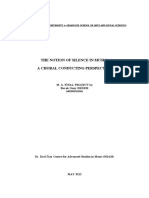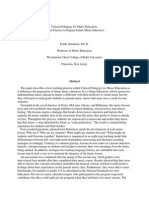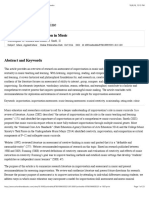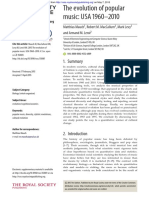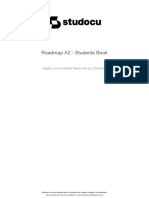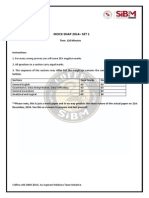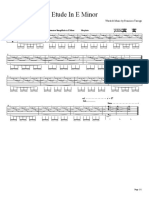0 ratings0% found this document useful (0 votes)
147 viewsUnit Plan - Strange Humors
Unit Plan - Strange Humors
Uploaded by
api-255265303Copyright:
© All Rights Reserved
Available Formats
Download as DOCX, PDF, TXT or read online from Scribd
Unit Plan - Strange Humors
Unit Plan - Strange Humors
Uploaded by
api-2552653030 ratings0% found this document useful (0 votes)
147 views10 pagesOriginal Title
unit plan - strange humors
Copyright
© © All Rights Reserved
Available Formats
DOCX, PDF, TXT or read online from Scribd
Share this document
Did you find this document useful?
Is this content inappropriate?
Copyright:
© All Rights Reserved
Available Formats
Download as DOCX, PDF, TXT or read online from Scribd
Download as docx, pdf, or txt
0 ratings0% found this document useful (0 votes)
147 views10 pagesUnit Plan - Strange Humors
Unit Plan - Strange Humors
Uploaded by
api-255265303Copyright:
© All Rights Reserved
Available Formats
Download as DOCX, PDF, TXT or read online from Scribd
Download as docx, pdf, or txt
You are on page 1of 10
1
Part One: Unit Plan
Course: Senior Years Band
Integrated Theme/Topic(s): (a) the exploration, understanding, and performance of
Middle Eastern folk music, (b) the historical significance of the djembe (including
djembe performance), and (c) arranging for chamber ensemble.
Essential Questions:
(a) What is Middle Eastern folk music? In what way does it influence Mackeys Strange
Humors?
(b) What is a djembe? What is its origin? What role does it play in the traditional music
of West Africa? How does one play a djembe?
(c) How can the same piece be realized in both small and large ensemble contexts?
Duration of Unit: 6 weeks (12-15 classes)
Stage 1 Setting Goals
1. Performance Goals:
Students will be able to (a) describe the elements of Middle Eastern folk music,
(b) perform a variety of Middle Eastern folk melodies by ear, (c) describe the historical
significance of the djembe to West African musical traditions, (d) perform basic rhythms
and patterns on the djembe, (e) arrange Strange Humors for chamber ensemble, (f)
perform the arrangement.
2. Demonstration:
2
Students will demonstrate (a) their comprehension of Middle Eastern folk music,
(b) their ability to perform the melodies of Middle Eastern folk music by ear, (c) their
comprehension of the historical significance of the djembe to West African musical
tradition, (d) their ability to perform basic patterns and rhythms on the djembe, (e) their
ability to arrange a large ensemble piece for chamber ensemble, (f) their ability to
perform their arrangement.
3. Product:
Students will produce (a) a completed quiz on Middle Eastern folk melodies, (b) a
class performance of Middle Eastern folk melodies, (c) a three-page written assignment
on the history of the djembe in the music of West Africa, (d) a chamber ensemble
arrangement and performance of John Mackeys Strange Humors.
4. Classroom Process:
Processes on which we will focus are (a) discussion, (b) reproduction of melodies
by ear, (c) musical performance, (d) collaborative arranging.
Stage 2 Curricular Connections
GLO SLO(s)
M-L1 Students develop skills for
making music individually and as
part of an ensemble
M-L1.1 Sing and/or play in tune, with increasing
control and accuracy, a sense of phrasing, and
musical expression, while maintaining own part
within an ensemble
M-L1.5 Demonstrate correct posture, playing
position, breath control, articulation, diction,
intonation, and appropriate technique and control of
instrument or voice
M-L1.9 Demonstrate appropriate interpersonal skills
for making music collectively
M-L2 Students develop skills for
making music through aural,
written, and visual music systems
M-L2.1 Play and/or sing by ear, reproducing
melodies, rhythms, accompaniments, and harmonies
with increasing accuracy, complexity, and
3
expression
M-L3 Students demonstrate
understanding of and facility with
rhythm, melody, texture, and
harmony in a variety of musical
contexts
M-L3.2 Perform rhythmic patterns accurately, based
on combinations of known durations
M-L3.7 Demonstrate understanding of
distinguishing characteristics of a variety of scales
and modes
M-L3.8 Identify and demonstrate various ways of
layering sounds to create texture and harmony
M-C1 Students generate and use
ideas from a variety of sources for
creating music
M-C1.1 Generate multiple ideas for music making
through constructive experimentation with music and
sound
M-C2 Students develop ideas in
music, creatively integrating
music elements, techniques, and
compositional tools
M-C2.1 Select, organize, and use a combination of
ideas, elements, and techniques for composing and
arranging musical pieces
M-C2.3 Demonstrate a valuing of risk taking as a
component of the creative process
M-C2.5 Collaborate with others to develop and
extend musical ideas
M-C3 Students interpret,
perform, and share their own and
others music
M-C3.1 Make interpretive musical decisions,
demonstrating an integrated understanding of
expressive devices and music elements
M-C3.3 Rehearse, revise, refine, and share own and
others music
M-C3.4 Make appropriate decisions as to whether
own work is finished
M-U1 Students experience and
develop awareness of music from
various times, places, social
groups, and cultures.
M-U1.1 Identify, describe, and compare music
experienced from different times, place, social
groups, and cultures.
M-U2 Students experience and
develop awareness of a variety of
music genres, styles, and
traditions.
M-U2.1 Identify and characterize a variety of
musical genres and styles.
M-U2.2 Demonstrate awareness of general
characteristics of music within groups (e.g., cultural,
social, historical contexts).
M-U3 Students demonstrate
understanding of the roles,
purposes, and meanings of music
in the lives of individuals and in
communities.
M-U3.1 Demonstrate understanding of the multiple
roles and purposes of music in society (e.g., for
enjoyment, persuasion, social commentary, mood
creation, spiritual experience, dancing).
M-U3.3 Demonstrate awareness of the intended
meanings and/or purposes of music encountered in
own performance and listening experiences.
M-U3.4 Demonstrate appreciation of music as a
means of experiencing the world and understanding
the perspectives of others.
M-V1 Students demonstrate M-V1.1 Engage consistently and constructively in
4
interest, curiosity, and
engagement while making and
experiencing music in a variety of
contexts
music learning experiences
M-V2 Students analyze their own
and others musical excerpts,
works and performances
M-V2.1 Analyze and demonstrate an integrated
understanding of own and others musical excerpts
and/or works in terms of relevant concepts
M-V2.2 Demonstrate understanding that detailed
observation, listening, and reflection inform musical
thinking, appreciation, performance, and creation
M-V2.3 Participate in identifying and using
appropriate criteria to discuss the quality and
effectiveness of own and others music
M-V4 Students assess their
learning in performing, creating,
and experiencing music
M-V4.3 Provide and respond to constructive
feedback based on appropriate criteria for assessing
musical experiences
M-V4.4 Assess own music-making process and
product using appropriate assessment criteria and
tools
Assessment:
Assessment For Assessment Of Assessment As
Tasks (a) Middle Eastern folk
melodies learned in class
by ear.
(b) Student
questions/discussion
regarding
arrangement/performance
assignment.
(a) Quiz on elements of
Middle Eastern folk
music.
(b) Performance of
Strange Humors
arrangement.
(c) Djembe written
assignment.
(a) Written reflection
regarding
arrangement/performance
assignment.
(b) Verbal assessment of
djembe
experience/performance.
Criteria (a) Accuracy of notes and
rhythms of reproduced
melodies;
appropriateness of style
and articulation.
(b) Generation and
implementation of
appropriate musical
ideas; use of musical
vernacular; appropriate
(a) Historical
significance;
modes/scales;
instrumentation;
social/spiritual
purposes.
(b) Incorporation of the
original material; form;
orchestration; accuracy
of notes and rhythms;
(a) Collaborative
process; notes and
rhythms; unforeseen
challenges; success of
original intent;
appropriateness of
original materials
representation.
(b) Ability to perform
patterns/rhythms; sound;
5
inter-student
collaboration.
style; articulation;
pulse; expression.
(c) Historical
significance; traditional
role in music and
society; how drum is
made.
feel; connection with
West African music.
Stage 3 Instruction
Teacher-Led Shared/Negotiated Student-Led
Middle Eastern folk music
discussion.
Arranging of Strange
Humors.
Learning of Middle Eastern
folk music melodies by ear.
Performance of Strange
Humors arrangement.
Djembe performance. Djembe research.
Stage 4 Learning Resources/Sources
Resources: student band instruments, djembe(s), Strange Homurs notation, recording.
6
Part Two: Activities
Activity One: Study of Middle Eastern folk music
Students will be broken into groups, each of which shall receive a CD of Middle
Eastern folk music (proposed track list can be found below). Students will listen to each
track and discuss the way the music sounds, describing the colors, textures, styles, and
instrumentation of each individual piece.
Student groups will then reconvene as a full class to engage in a secondary
discussion. This discussion shall be facilitated by the instructor whose primary concern
should be centered upon eliciting musically appropriate feedback from each group and
directing the subsequent class-wide conversation. This conversation shall be
accompanied by the musical notation for a few of the exemplars found on the CD for the
purposes of making analytical connections between the subject matter and previously
held knowledge pertaining to scales, modes, and melodies.
This activity is to be paired with a quiz to be taken following activity two (see
below).
Track List:
Galolee Abdul Majeed Abdullah
Pokare Kare Ana Hayley Westenra
Habibi Lahibi Jalilah
Ah Ya Zayn Mohammad El-Bakkar
Nosevo Lamame Al-Kindi
Ezoulm Dha Kan Lih Mohamed Abdel Wahab
Nezo Bonovae Saleem Bashir
7
Activity Two: Reproduction of Middle Eastern folk music
Students will learn a series of traditional Middle Eastern folk melodies by ear
through echoing with the instructor. These melodies, all of which would originate from
the track listing above, would be accompanied by a brief overview of each songs
historical implications and traditional purpose.
8
Middle Eastern Folk Music Quiz
1. Name four (4) primary musical qualities of Middle Eastern folk music.
2. Name two pieces learned in class. Describe the historical and/or cultural
implications of each piece.
3. Name a scale or mode that is frequently used in Middle Eastern folk music.
What is the key identifying element of this scale or mode?
4. Does the Middle Eastern folk music heard in class remind you of a piece you
have played before? If so, which one? Why?
Activity Three: Djembe Research and Performance
Students will be given an introduction to the djembe in class, including
introductory information pertaining to its history, its use in traditional West African
music, and its design. Students will follow this in-class introduction by completing a
research paper a minimum of three pages in length pertaining to the djembe. This paper is
to be assessed on its description of the djembes traditional usage, history, design, and
connection to West African culture and spirituality. The assignment will not be assessed
on the students ability to write in an academic fashion.
More importantly, students are to be given an opportunity to play the djembe.
Though the type of instruction pertaining to this activity will be dependent upon the
number of djembes the school can provide, it would be ideal for each individual to have
his or her own djembe to learn as a class. Students would be instructed on the basic
sounds that can be elicited from the djembe along with traditional West African rhythms
9
and patterns. The instructor would be well advised to include external video instruction
(ie. YouTube videos, instructional DVDs, etc.) to enhance the authenticity of teaching.
Activity Four: Arrangement of Strange Humors
This activity would prefaced by introducing the class to Strange Humors in the
context for which it was originally composed string quartet and djembe. Following the
playing of the recording, students would engage in a teacher-facilitated discussion
regarding the nature of chamber music and arranging. The instructor should make
frequent use of questioning in order to engage students in critical thinking regarding what
musical elements go into creating a piece of music and how these elements can be varied
between small and large ensemble contexts.
Following this discussion, the class is to be split into chamber ensembles made up
of no more than six musicians each (these ensembles shall be made at the discretion of
the instructor). Each group is to receive both the large and small ensemble recordings of
Strange Humors along with a large ensemble score. Each group will be tasked with the
challenge of rearranging Strange Humors in such a way that suits their particular small
ensemble. Students will not be expected to follow the precise roadmap of the original
score, but will be expected to include each musical theme of the piece in their
arrangement (ie. no major themes are to be omitted).
Following the completion of their arrangement (which the students may or may
not choose to notate), each student will be required to write a one-page self-reflection
regarding the challenges of rearranging a large ensemble piece for a small ensemble.
Students will reflect upon the arrangement process as it pertained to their successes, their
10
failures, things they would do differently next time, the effectiveness of the groups
collaboration, and any remaining questions they may have. Students are also to be
assessed on their performance of their arrangement using the following checklist.
Beginning Developing Developed
Treatment of source material (ie.
musical themes present, harmonized
correctly, etc.)
Orchestration
Accuracy of notes and rhythms
Blend, balance, style, dynamics,
articulation
You might also like
- RCM HarmonyDocument39 pagesRCM Harmonybleufee100% (1)
- Give It Up - KC and The Sunshine Band - Tenor Sax.Document3 pagesGive It Up - KC and The Sunshine Band - Tenor Sax.Rodrigo Alonso Garrido Stuardo100% (4)
- The Blanket by Floyd Dell PDFDocument3 pagesThe Blanket by Floyd Dell PDFCristine Morandante Boniao50% (2)
- An Interpretive Guide To Operatic Arias - A Handbook For Singers, Coaches, T PDFDocument632 pagesAn Interpretive Guide To Operatic Arias - A Handbook For Singers, Coaches, T PDFHoa Bui100% (3)
- How Far Ill GoDocument9 pagesHow Far Ill GoCHELSY FRANCHETTE ROSELL80% (5)
- The Notation Is Not The Music ReflectioDocument4 pagesThe Notation Is Not The Music ReflectioErick Do Carmo100% (1)
- Hughes - A Model of Musical MemoryDocument6 pagesHughes - A Model of Musical MemoryMaría Hernández Miravete100% (1)
- Instructional MethodsDocument21 pagesInstructional Methodsapi-478241685No ratings yet
- La Traviata - Opera Classics LibraryDocument112 pagesLa Traviata - Opera Classics LibraryIvan Hockley100% (3)
- Performing Ethnomusicology: Teaching and Representation in World Music EnsemblesFrom EverandPerforming Ethnomusicology: Teaching and Representation in World Music EnsemblesRating: 5 out of 5 stars5/5 (1)
- Assessment in Music Education: Theory, Practice, and Policy: Selected Papers from the Eighth International Symposium on Assessment in Music EducationFrom EverandAssessment in Music Education: Theory, Practice, and Policy: Selected Papers from the Eighth International Symposium on Assessment in Music EducationNo ratings yet
- Musicians from a Different Shore: Asians and Asian Americans in Classical MusicFrom EverandMusicians from a Different Shore: Asians and Asian Americans in Classical MusicRating: 3.5 out of 5 stars3.5/5 (2)
- 3Document23 pages3pacurarNo ratings yet
- Taffanel Pat 2Document37 pagesTaffanel Pat 2BergJunior100% (2)
- ResearchBibliography PDFDocument12 pagesResearchBibliography PDFERHAN0% (1)
- ALC 342 Unit 1 The History of The FluteDocument9 pagesALC 342 Unit 1 The History of The FluteDouglas McNamesNo ratings yet
- International Journal of Music EducationDocument11 pagesInternational Journal of Music EducationRenato CardosoNo ratings yet
- Khachaturian Piano ConcertoDocument1 pageKhachaturian Piano Concertochris_isipNo ratings yet
- Development and Evaluation of PDFDocument461 pagesDevelopment and Evaluation of PDFCleiton XavierNo ratings yet
- Dissertation PDFDocument158 pagesDissertation PDFAnonymous ixIpG5jNNo ratings yet
- FluteDocument4 pagesFluteSomya SinghalNo ratings yet
- The OrffDocument3 pagesThe OrffMo FaNo ratings yet
- Teaching Stage Fright Implications For Music EducatorsDocument14 pagesTeaching Stage Fright Implications For Music EducatorscsabaNo ratings yet
- Transatlantic Pedagogy, FinalDocument23 pagesTransatlantic Pedagogy, Finalcalebjm19910% (1)
- Notation Perform A 00 WillDocument190 pagesNotation Perform A 00 WillCeiba GrooveNo ratings yet
- Sonata Form Analysis Study Skills FinalDocument4 pagesSonata Form Analysis Study Skills FinalAnonymous DMDqWeNo ratings yet
- Concept of An Integrated Chamber Music CurriculumDocument49 pagesConcept of An Integrated Chamber Music CurriculumBruno CostaNo ratings yet
- Expression: The Essence of Music: A Guide To Expressive PerformanceFrom EverandExpression: The Essence of Music: A Guide To Expressive PerformanceNo ratings yet
- Notation and Performance of New Music, Earle BrownDocument23 pagesNotation and Performance of New Music, Earle BrownLila LilaNo ratings yet
- Flute Talk December 2013 - Final PDFDocument2 pagesFlute Talk December 2013 - Final PDFAngelo Malerba100% (1)
- Burrton USD 369 Band CurriculumDocument26 pagesBurrton USD 369 Band Curriculumjordan_northernsNo ratings yet
- The Virtuosic FlutistDocument2 pagesThe Virtuosic FlutistAlexander Davadilla25% (4)
- ST Cecilia School of Music Recorder SyllabusDocument18 pagesST Cecilia School of Music Recorder SyllabussadNo ratings yet
- Bayley FluteVIbratoDocument4 pagesBayley FluteVIbratoBrianna WilliamsNo ratings yet
- Orchestra Rehearsal Strategies: Conductor and Performer ViewsDocument16 pagesOrchestra Rehearsal Strategies: Conductor and Performer ViewsElision06No ratings yet
- William T. Eveleth - Blues, Jazz & Rock Riffs For KeyboardsDocument72 pagesWilliam T. Eveleth - Blues, Jazz & Rock Riffs For KeyboardsJuan Triviño ZetsubōNo ratings yet
- Minimalism PDFDocument26 pagesMinimalism PDFfrank orozcoNo ratings yet
- SkillsourcefluteDocument3 pagesSkillsourceflutepd_fierroNo ratings yet
- An Overview of Pedagogical Techniques of Vibrato For The Flute PDFDocument100 pagesAn Overview of Pedagogical Techniques of Vibrato For The Flute PDFAskitNo ratings yet
- The Idylle Op. 116 (Flute)Document0 pagesThe Idylle Op. 116 (Flute)John Michael LauronNo ratings yet
- History of Music EducationDocument5 pagesHistory of Music EducationSean McGinley100% (2)
- Andre Jolivets Fusion Magical Music Conventional Lyricism andDocument72 pagesAndre Jolivets Fusion Magical Music Conventional Lyricism andjuli_solesNo ratings yet
- Music in The Twentieth and Twenty-First Centuries, by Joseph Auner (Excerto)Document4 pagesMusic in The Twentieth and Twenty-First Centuries, by Joseph Auner (Excerto)Pedro Oliveira0% (1)
- Training 21st Century Flutists HandoutDocument3 pagesTraining 21st Century Flutists Handoutsallyflute10% (1)
- Daniel Leech-Wilkinson - Early Recorded Violin Playing: Evidence For What?Document19 pagesDaniel Leech-Wilkinson - Early Recorded Violin Playing: Evidence For What?lemon-kunNo ratings yet
- UH Pedagogy of Music Theory Syllabus PDFDocument12 pagesUH Pedagogy of Music Theory Syllabus PDFthetrumanshow100% (1)
- Music Theory Aural Skills PedagogyDocument1 pageMusic Theory Aural Skills PedagogyИван Петрович ПетровNo ratings yet
- Music Appreciation SyllabusDocument4 pagesMusic Appreciation Syllabusjudy_huang7363100% (1)
- The Notion of Silence in MusicDocument74 pagesThe Notion of Silence in MusicBurak Onur Erdem100% (1)
- Beginning Band Example Recruitment Outline LetterDocument3 pagesBeginning Band Example Recruitment Outline Letterapi-643288266No ratings yet
- A Sequential Approach To Etudes Part3Document10 pagesA Sequential Approach To Etudes Part3neNo ratings yet
- Abrahams CPME Best PracticesDocument9 pagesAbrahams CPME Best PracticesenchufenchufadosNo ratings yet
- Van Keulen, Geert - 12 Studies For Flute Solo PDFDocument23 pagesVan Keulen, Geert - 12 Studies For Flute Solo PDFJoãoFerreira100% (1)
- Studies in EthnomusicologyDocument18 pagesStudies in Ethnomusicologytyjc87No ratings yet
- Peter and The Wolf Teacher's GuideDocument47 pagesPeter and The Wolf Teacher's GuideThiago AraújoNo ratings yet
- For The Analysis of Musical Style (New York: W. W. Norton, 1970)Document4 pagesFor The Analysis of Musical Style (New York: W. W. Norton, 1970)Adailton0% (1)
- Sisley, B. A. (2008) - A Comparative Study of Approaches To Teaching Melodic Dictation (Doctoral Dissertation, Kent State University) .Document49 pagesSisley, B. A. (2008) - A Comparative Study of Approaches To Teaching Melodic Dictation (Doctoral Dissertation, Kent State University) .goni565090% (1)
- Quality of RepertoireDocument16 pagesQuality of RepertoireMichael CottenNo ratings yet
- Gcse Mus Revised SupportDocument76 pagesGcse Mus Revised SupportBoatman Bill100% (1)
- Gordon Learning TheoryDocument4 pagesGordon Learning Theoryapi-282445044No ratings yet
- Bassoon Reed-Making - A Basic TechniqueDocument2 pagesBassoon Reed-Making - A Basic Techniqueapi-236899237No ratings yet
- Assessment of Improvisation in Music Oxford HandbooksDocument23 pagesAssessment of Improvisation in Music Oxford HandbooksRui Leite100% (1)
- Quantz and The Transverse Flute (Edward R. Reilly)Document12 pagesQuantz and The Transverse Flute (Edward R. Reilly)Sean QuinnNo ratings yet
- Improvisation in The Aural Curriculum-An ImperativeDocument17 pagesImprovisation in The Aural Curriculum-An Imperativer-c-a-d100% (2)
- Performance Directions: Grade 3 Music TheoryDocument13 pagesPerformance Directions: Grade 3 Music TheoryBelinda LohNo ratings yet
- I Fall in Love Too Easily - Chord Melody (Version Gratuita)Document2 pagesI Fall in Love Too Easily - Chord Melody (Version Gratuita)Federico TierraNo ratings yet
- Злив НМТ англійська мова 18 травня 2024Document6 pagesЗлив НМТ англійська мова 18 травня 2024Виктория Скарло100% (1)
- Unit 3Document13 pagesUnit 3parthiv T.NNo ratings yet
- LCD Soundsystem - Losing My Edge Lyrics Genius LyricsDocument1 pageLCD Soundsystem - Losing My Edge Lyrics Genius LyricsmilesrstraceyNo ratings yet
- Digital Booklet - Argo - Original Mot PDFDocument5 pagesDigital Booklet - Argo - Original Mot PDFДенис СалаховNo ratings yet
- "From Jimmy Castor To Grandmaster Flash - The Role of Morrisania in Hip-Hop's Evolution" by Mark NaisonDocument9 pages"From Jimmy Castor To Grandmaster Flash - The Role of Morrisania in Hip-Hop's Evolution" by Mark NaisongiampiNo ratings yet
- The Evolution of Popular Music: USA 1960-2010Document10 pagesThe Evolution of Popular Music: USA 1960-2010Southern California Public RadioNo ratings yet
- Pehealth 12 Q1 Module 12Document6 pagesPehealth 12 Q1 Module 12Rea Mae Josefa TarocNo ratings yet
- Music For Prague 1968 AnalysisDocument11 pagesMusic For Prague 1968 AnalysisCristian RipollNo ratings yet
- SicilianaDocument2 pagesSicilianaFrancisco AlhamaNo ratings yet
- Rollins ExcerptsDocument14 pagesRollins ExcerptsChris SmithNo ratings yet
- True Colors ChordDocument2 pagesTrue Colors ChordCynthia ElizabethNo ratings yet
- Roadmap A2 Students BookDocument162 pagesRoadmap A2 Students BookMariano Di BaccoNo ratings yet
- Thesis Artem Zenev PDFDocument28 pagesThesis Artem Zenev PDFIlya KryzhanovskyNo ratings yet
- Moller Tecnique, Some Information - For DrummerDocument2 pagesMoller Tecnique, Some Information - For DrummerDario Congedo100% (2)
- Mock Paper 1Document28 pagesMock Paper 1Bala JishnuNo ratings yet
- The Punisher (Guitar Tab)Document2 pagesThe Punisher (Guitar Tab)Doğukan KıyıklıkNo ratings yet
- Indi Dino Morin DinoDocument4 pagesIndi Dino Morin Dino20012748No ratings yet
- Hanan Tabouhot - Music Theory - A Fun and Easy Guide To Understanding Music (2021)Document216 pagesHanan Tabouhot - Music Theory - A Fun and Easy Guide To Understanding Music (2021)sfjeimfedzotjqkuwoNo ratings yet
- Publication 1Document1 pagePublication 1api-287798342No ratings yet
- Tarrega, Francisco - Etude in E MinorDocument1 pageTarrega, Francisco - Etude in E MinorIsait Rosas EspinosaNo ratings yet
- Elisha Zimbeva BioDocument10 pagesElisha Zimbeva BioElisha ZimbevaNo ratings yet
- U002 - Elvis Presley - Its Now or NeverDocument1 pageU002 - Elvis Presley - Its Now or NeverMax MaierNo ratings yet






